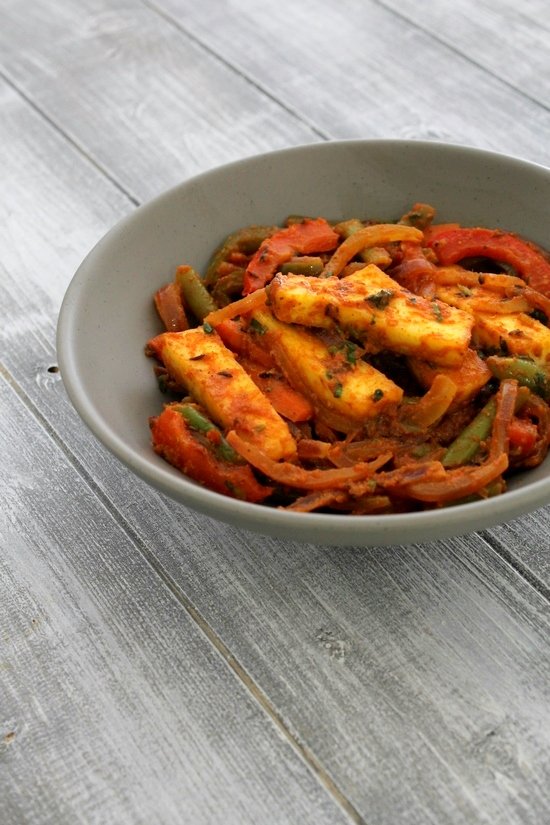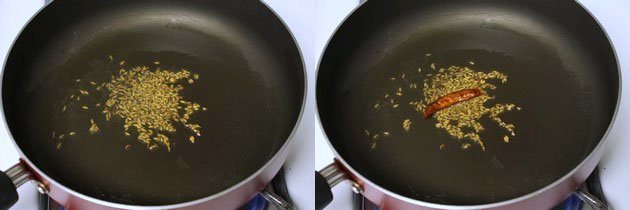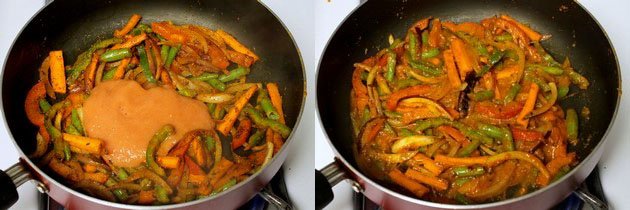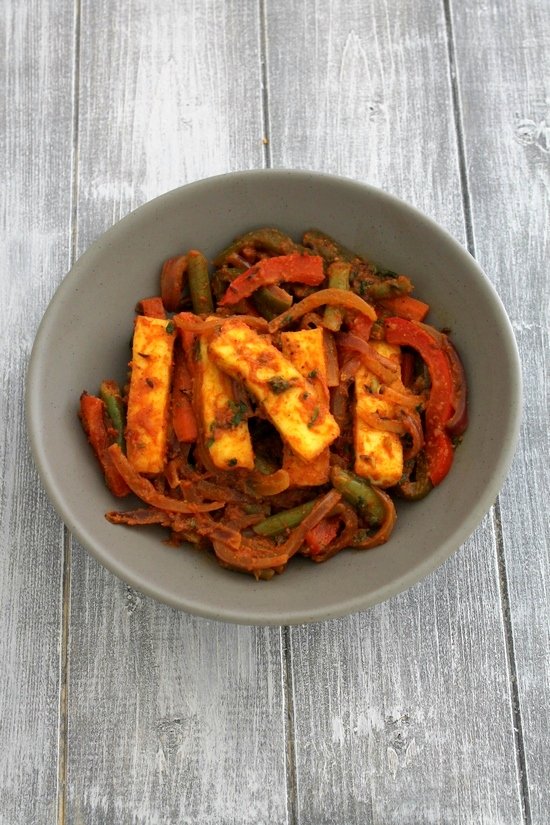Paneer Jalfrezi is a vibrant, semi-dry Indian curry where tender paneer cubes and colorful vegetables are tossed in a spicy, tangy, and thick masala. It’s a quick stir-fry-style dish that brings bold flavors and bright textures to your plate.

Ever wondered what Jalfrezi actually means? You’re not alone—I used to enjoy this dish at restaurants without giving the name much thought. But after experimenting with the recipe at home, I delved into its roots and discovered its interesting history.
Jalfrezi has its origins in the British Raj era, when Anglo-Indian kitchens repurposed leftover meats and vegetables by stir-frying them with chili, onions, and spices. It evolved into a flavorful fusion dish—essentially the Indian twist on a Chinese-style stir-fry. The name comes from the Bengali word “jhal” meaning spicy or hot, which perfectly describes the dish’s fiery character.
What makes Jalfrezi truly distinctive is its bold combination of spiciness and tanginess. Moreover, the addition of vinegar and tomato purée introduces a sharp, zesty note that enhances and brightens the overall flavor of the dish. In this homemade version of paneer jalfrezi, I’ve used a colorful mix of vegetables—onions, capsicum, carrots, and green beans—paired with soft, juicy paneer cubes for a hearty and flavorful experience.
Traditionally, the vegetables are blanched first and then stir-fried with the masala. However, in this version, I simplify the process by cooking all the ingredients together in one pan. This not only saves time but also allows the vegetables to absorb the spices more deeply, enhancing the overall flavor. This not only saves time but also lets the vegetables soak in all the spicy, tangy flavors. The result is a colorful, quick, and satisfying dish that pairs perfectly with roti, naan, or rice.
Ingredients For Paneer Jalfrezi:
- 2 tablespoons oil – Use any neutral oil suitable for sautéing, like sunflower or vegetable oil.
- 100 grams (3.5 oz) paneer – Cut into long, thick strips about 1½ inches for better texture and bite.
- ½ teaspoon cumin seeds – Adds a warm, earthy flavor as the tempering base.
- 1 dried red chili – Break it slightly for a subtle smoky heat.
- ½ cup sliced red onion – Thinly sliced to bring mild sweetness and crunch.
- ⅓ cup thinly sliced carrots – Adds natural sweetness and color.
- ⅓ cup green beans – Cut into 1-inch pieces for a uniform look and even cooking.
- ¼ cup sliced green capsicum (bell pepper) – Brings crunch and mild bitterness to balance flavors.
- ½ cup red bell pepper, thinly sliced – Adds vibrant color and a mild natural sweetness to the dish.
- ¼ inch piece of fresh ginger, julienned – Provides sharp, aromatic warmth.
- ¼ teaspoon turmeric powder – Lends a warm golden hue and a gentle, earthy flavor to the curry.
- 1½ teaspoons red chili powder – Brings heat and vibrant color; you can vary the amount to suit your spice tolerance.
- 1 teaspoon coriander powder – Enhances the overall flavor with citrusy undertones.
- ½ teaspoon garam masala – Adds a finishing touch of warm, aromatic Indian spices to elevate the flavor.
- Salt to taste – Adjust as needed.
- 1 medium tomato (approx. ¾ cup), pureed – Creates the base of the tangy, spiced gravy.
- ¼ cup water – Helps adjust the consistency of the curry.
- ¼ teaspoon sugar – Balances the acidity from the tomatoes and vinegar.
- 1 teaspoon white vinegar – Adds a mild tang to brighten the dish.
- 1 tablespoon fresh coriander leaves, finely chopped – For garnish and a fresh herbal finish.
Step-by-Step Instructions:
1) Prepare Ahead: Begin by prepping all the vegetables—slice the onions, julienne the carrots and bell peppers, trim and chop the green beans, and cut the paneer into long strips. Also, measure out all your spices and other ingredients before you start cooking to keep the process smooth.
2) Lightly Sauté the Paneer: Warm 1 tablespoon of oil in a heavy-bottomed or non-stick pan over medium heat. Once hot, gently place the paneer strips in a single layer.
3) Flip and Cook Evenly: Let the paneer cook undisturbed until a light golden layer appears on one side, then gently turn to cook the other side. Flip and repeat on the other side. Take care not to overcook—the aim is to lightly sauté the paneer, not to make it too brown or crispy. Over-frying will make paneer rubbery and dry. Once done, remove to a plate.
Tip: To ensure the paneer stays soft, especially when using frozen or store-bought varieties, soak the fried pieces in warm water for 10–15 minutes. After soaking, gently press the paneer to remove excess moisture before adding it to the dish. If you’re working with fresh homemade paneer, it’s naturally soft and tender, so soaking is usually not necessary.

4) Add Remaining Oil: In the same pan, pour in the remaining 1 tablespoon of oil and heat it up.
5) Infuse with Spices: Once the oil is heated, add cumin seeds and let them sizzle until they release their nutty aroma. Then toss in the dried red chili and sauté for about 30 seconds until it deepens in color and releases its aroma.

6) Add Veggies: Now add all your prepped vegetables—sliced onions, julienned carrots, chopped green beans, both red and green capsicum, and ginger juliennes.
7) Sauté: Stir well and cook the vegetables for 2–3 minutes, just until they begin to soften slightly but still retain their crunch.

8) Spice It Up: Sprinkle in salt, turmeric, red chili powder, coriander powder, and garam masala.
9) Mix and Coat: Stir everything thoroughly so that the spices coat the vegetables evenly. Cook for another minute, allowing the spices to roast gently and deepen in flavor.

10) Incorporate Tomato Purée: Add the tomato purée and mix thoroughly, letting it blend smoothly with the sautéed vegetables and spices.
11) Simmer: Mix thoroughly and cover the pan with a lid. Allow the mixture to simmer on medium-low heat for 10–12 minutes, until the vegetables are tender yet still hold their shape.

12) Add Tang and Balance: Once the veggies are tender, add sugar and white vinegar. These two ingredients give the dish its signature balance of tangy and slightly sweet flavors.
13) Final Touches: Pour in ¼ cup of water to loosen the gravy slightly. Then add the fried paneer strips and freshly chopped coriander leaves.

14) Combine Gently: Carefully fold everything together so that the thick masala coats all the paneer and vegetables. Be gentle to avoid breaking the paneer pieces. Let it cook uncovered for 2 more minutes on low heat, just until everything is well mixed and heated through.
15) Serve: Turn off the heat and transfer the paneer jalfrezi to a serving bowl. This is a semi-dry curry where the paneer and vegetables are wrapped in a bold, spicy, and tangy masala. Serve hot with roti, naan, or jeera rice.

Serving Suggestions For Paneer Jalfrezi:
Paneer Jalfrezi, with its bold spices and tangy undertones, is a versatile semi-dry curry that complements a variety of Indian accompaniments. Whether you’re preparing a simple family dinner or an elaborate festive spread, pairing it right elevates the overall dining experience.
Bread Pairings
Phulkas or Soft Rotis: These whole wheat flatbreads are a classic, healthy option that pair beautifully with the spiced paneer and vegetables. Their softness helps scoop up the thick masala coating, making every bite satisfying yet light, perfect for everyday meals.
Lachha Paratha: This layered, flaky paratha adds a rich, buttery contrast to the spicy notes of jalfrezi. The multiple layers soak up the tangy gravy beautifully, giving you a restaurant-style indulgence at home.
Butter Naan or Garlic Naan: If you’re aiming for a richer meal, naan is a fantastic choice. The buttery softness or garlicky flavor of these leavened breads balances the heat in the curry while absorbing the masala perfectly.
Kulcha: Slightly thicker and more crisp than naan, kulchas offer a lovely texture contrast to the tender paneer and crunchy vegetables. You can also try stuffed kulchas like onion or paneer-stuffed ones for an extra burst of flavor.
Rice Combinations
If you prefer a rice-based meal, Paneer Jalfrezi pairs equally well with:
Jeera Rice: Fragrant basmati rice tempered with cumin seeds adds a simple yet flavorful base that allows the jalfrezi to shine.
Peas Pulao: The mild sweetness of green peas complements the spicy and tangy flavors of the dish, creating a well-balanced plate.
Plain Steamed Rice: When you’re looking for comfort food, steamed rice served with this curry is a no-fuss, homestyle option. It allows the bold flavors of the paneer jalfrezi to stand out without any distractions.
Side Dishes and Condiments
To round out the meal and balance the spice, consider adding one or more of these refreshing sides:
Cucumber or Boondi Raita: A chilled yogurt-based side helps cool the palate and adds creaminess that contrasts the dry texture of the jalfrezi.
Mint Chutney: This tangy, herby condiment cuts through the richness and adds a burst of freshness to each bite.
Kacha Salad: A mix of thinly sliced onions, cucumber, carrots, and lemon wedges adds crunch and a zesty twist. For an added burst of flavor, sprinkle some chaat masala over the salad just before serving.
Consequently, these accompaniments not only elevate the overall dining experience but also bring diversity in taste and texture, making your paneer jalfrezi a well-rounded and memorable meal.

Expert Tips for Perfect Paneer Jalfrezi
1. Use Fresh Paneer for Best Texture:
Homemade paneer yields the softest and most flavorful results. If you’re using frozen or packaged paneer, it’s best to soak it in warm water after frying to help restore its softness and prevent a chewy texture. This helps restore its softness and prevents a rubbery texture.
2. Don’t Overcook the Vegetables:
Jalfrezi is known for its slightly crunchy vegetables. Sauté just until they are tender yet crisp. Overcooking can lead to a mushy texture and loss of vibrant colors.
3. Maintain Medium Heat:
Cook the spices and vegetables on medium to medium-low heat. This allows the flavors to develop without burning the spices or drying out the masala.
4. Adjust Spice Levels to Taste:
The recipe uses a fair amount of red chili powder, but you can reduce it if you prefer a milder version. Alternatively, use Kashmiri chili powder to retain color without too much heat.
5. Use Tomato Purée, Not Fresh Tomatoes:
Tomato purée provides a smooth, thick base that clings well to paneer and vegetables. Fresh chopped tomatoes may water down the gravy and change the texture.
